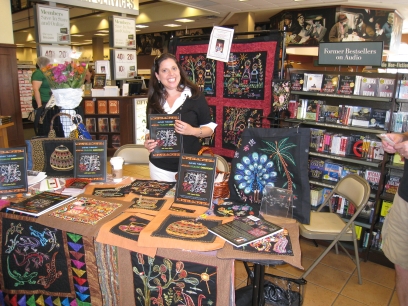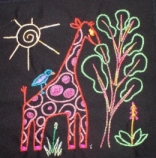
TALL , GRACEFUL AND ELEGANT- GIRAFFES
The Giraffe, the tallest animal in Africa is both elegant and graceful. Its height allows it to keep in contact with other giraffes over large distances as well as spotting predators from afar. It is not uncommon to see other animals following a giraffe using it as an early predator warning system. The neck is so long the giraffe must spread its front legs apart so its head can reach the ground to drink. It has unusually elastic blood vessels with a series of valves that help offset the sudden buildup of blood (and to prevent fainting) when the head is raised, lowered or swung quickly.
 The giraffe's high shoulders and sloping back give the impression that its front legs are much longer than the hind legs, but they are in fact only slightly longer. The giraffe stands at eighteen feet and weighs up to 3000 pounds. Giraffes are herbivorous browsers. When protected, giraffes can flourish in areas where food is abundant year round. Although they drink water when it's available, they can survive where it is scarce. Giraffes occasionally eat grass and fruits of various trees and shrubs, but their principal food source is the acacia tree.
The giraffe's high shoulders and sloping back give the impression that its front legs are much longer than the hind legs, but they are in fact only slightly longer. The giraffe stands at eighteen feet and weighs up to 3000 pounds. Giraffes are herbivorous browsers. When protected, giraffes can flourish in areas where food is abundant year round. Although they drink water when it's available, they can survive where it is scarce. Giraffes occasionally eat grass and fruits of various trees and shrubs, but their principal food source is the acacia tree.
Before we begin our visual safari, let's refresh with the basic rules of African Folklore Embroidery. Whatever color you choose to stitch is the right color - there is no wrong color. If you wish to stitch your giraffes pink or your sun blue - go for it! Your stitches do not need to be perfect - there are no needle art police who are going to come and inspect your work! The needles are only to be used for stitching, no poking anyone or sewing yourself! (obvious- but worth mentioning) You do NOT NEED A HOOP! Have fun- you are creating a visual art, a fiber art, a wearable art. Whether you are an accomplished quilter, sophisticated stitcher, wonderful knitter or have never held a needle before, you will be stunned by the ease and beauty of African Folklore Embroidery.
 Chain stitch is the dominant stitch in African Folklore Embroidery and like most ethnic types and folklore embroidery, chain stitch is the popular stitch used. It is a very rhythmical stitch, easy to do and flows beautifully. Once you are in the rhythm of the chain stitch with your African Folklore Embroidery, it is easy to do other things such as watching television, riding on a plane or train, watching a basketball or soccer game. I usually take mine with me wherever I go; I fold it up and put it in my purse. Since you can take needles on a plane, I have found that taking this traveling allows me guilt-free time to pursue my favorite hobby.
Chain stitch is the dominant stitch in African Folklore Embroidery and like most ethnic types and folklore embroidery, chain stitch is the popular stitch used. It is a very rhythmical stitch, easy to do and flows beautifully. Once you are in the rhythm of the chain stitch with your African Folklore Embroidery, it is easy to do other things such as watching television, riding on a plane or train, watching a basketball or soccer game. I usually take mine with me wherever I go; I fold it up and put it in my purse. Since you can take needles on a plane, I have found that taking this traveling allows me guilt-free time to pursue my favorite hobby.
Here is an example of what the design will look like on completion. I will take you step by step through this project, which is the same design I worked on for the television show Uncommon Threads on the DIY channel (HGTV, Uncommon Threads). Since my kits include the design, a needle and African threads, all you need is scissors. Please remember that this is just one interpretation of the giraffe. Should you desire, you can incorporate and add African hand-dyed and variegated threads and beads. Any beads can be used - I suggest beads with a good-sized eye - and bright colored beads are great to use, along with needle threaders (to help with threading the needle). Look at your design and decide where you would like to begin and what color you would like. I suggest starting with the outline of one of features of the design, so for example the outline of the giraffe or the outline of the sun or the tree.
Once you have chosen your thread color, thread your needle. Only use one thread and do not split the thread. You want to single thread your needle and tie a knot at the end about an inch away from the  end. If you have a child working on one of our designs, my suggestion is to double thread the needle. Starting with chain stitch, bring the threaded needle through the fabric at the beginning of the design, and hold it down with the left thumb. Thread the needle into the fabric from the front (where the thread last came out) and bring the point of the needle out of the fabric a short distance away. Do not worry about the spacing and size of your stitches. If there are spaces that's great, as later we will use different colored thread in between the spaces.
end. If you have a child working on one of our designs, my suggestion is to double thread the needle. Starting with chain stitch, bring the threaded needle through the fabric at the beginning of the design, and hold it down with the left thumb. Thread the needle into the fabric from the front (where the thread last came out) and bring the point of the needle out of the fabric a short distance away. Do not worry about the spacing and size of your stitches. If there are spaces that's great, as later we will use different colored thread in between the spaces.
Bring the thread up at the top of the line and hold it down with the left thumb. Insert the needle where it last emerged and bring the point out a short distance away. Pull the thread through, keeping the working thread under the needle. Pull the needle through and keep working the thread under the needle point, making the chain. You will find that you develop your own level of consistency regarding the size of your stitches.
Happy stitching and see you next time with your camera for our visual safari
Best,
Leora Raikin




